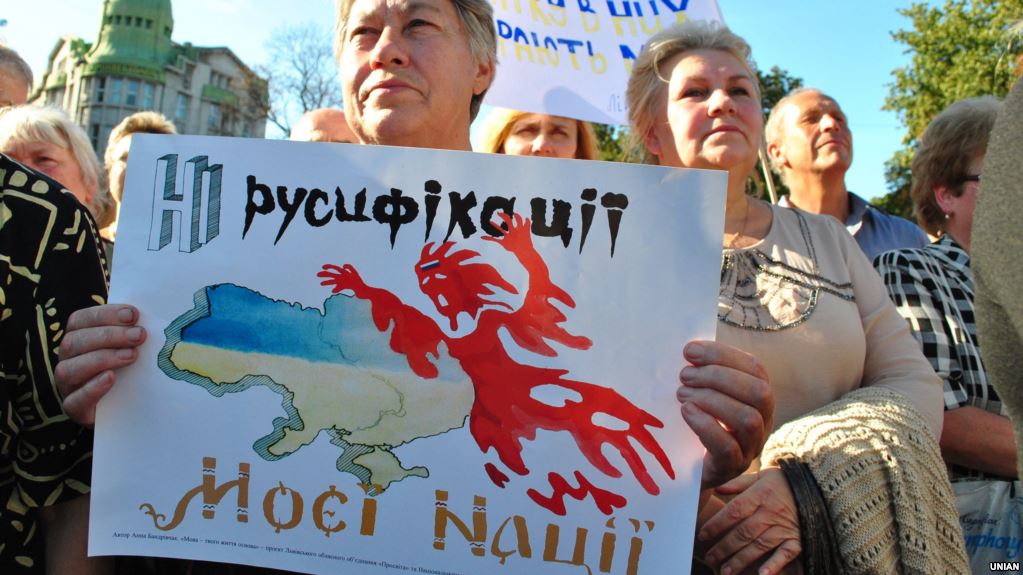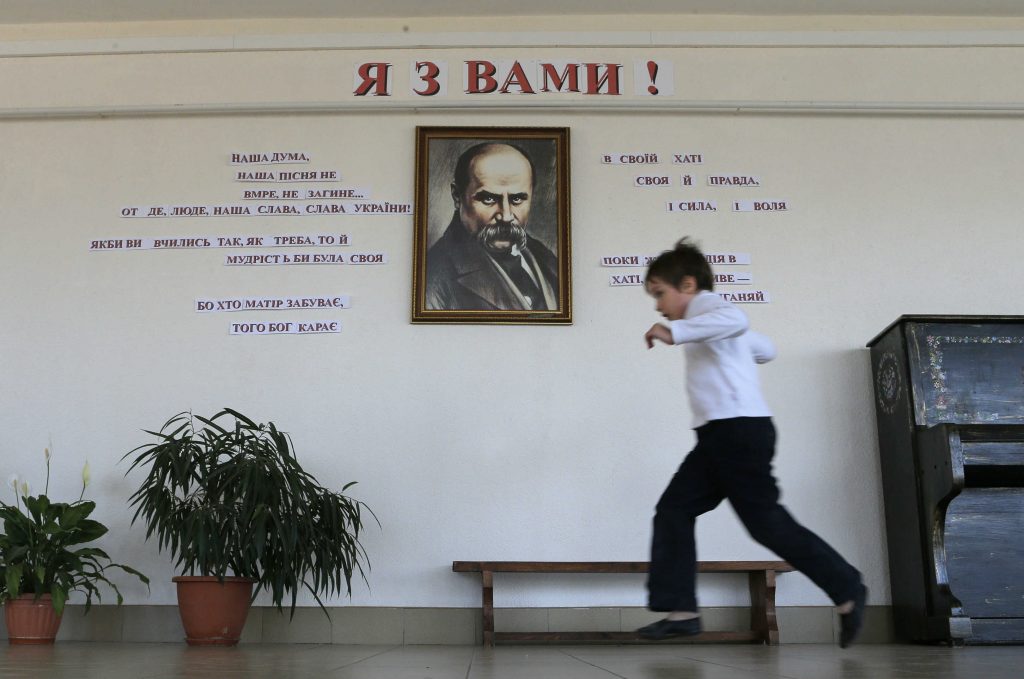A pupil runs by a portrait of Ukrainian poet Taras Shevchenko at a local school in Simferopol, April 10, 2014. Natalia Rudenko’s ears were still ringing from being shouted at by a father demanding that the Ukrainian-language school she has run for 17 years in Crimea’s capital now teach in Russian when local officials turned up at her office to dismiss her. Their message: Rudenko and her school dedicated to sending students to Ukrainian universities no longer have a place in a society that voted to secede from Ukraine and join Russia last month after Moscow deployed troops across the Black Sea peninsula. Picture taken April 10, 2014. REUTERS/Maxim Shemetov
The text was originally published by the Atlantic Council in the UkraineAlert blog.
What was in the Kivalov-Kolesnichenko language law? The law kept Ukrainian as the state language, yet considerably expanded the use of regional languages, should the native speakers of these languages constitute at least 10 percent of the population of a region. The law embraced eighteen languages but was clearly directed at Russian, as few of the other languages met the 10 percent threshold in any region.
Which regions fell within the law’s scope of action? After the law was passed, Russian became an official regional language in thirteen of Ukraine’s twenty-seven administrative units: Kyiv, the Autonomous Republic of Crimea, and Donetsk, Luhansk, Dnipropetrovsk, Zaporizhia, Odesa, Kherson, Mykolayiv, Kharkiv, Sumy, and Chernihiv Oblasts.
What was the response to the Kivalov-Kolesnichenko law in 2012? The law resulted in a heated public discussion. There was political opposition, and citizens and much of the expert community spoke against the law. To many, the law was a political gesture aimed at dividing Ukrainian society. Those in opposition argued that the law should have been based on the will of the people rather than imposed in a top-down manner; they also pointed out that the threshold for a language’s special status should have been 50 percent of a region’s population, not 10 percent. Given a 50 percent threshold, Russian would have qualified in only Crimea and Donetsk and Luhansk regions.
None of the language institutions of the National Academy of Sciences supported the law. The Ministry of Finance stated that it would cost between $1.5 and $2.1 billion annually to implement the law and did not support its adoption. Internationally, the Venice Commission stated that the draft law failed to ensure a balance between the use of the state language as a consolidating factor for society, and the protection of minority languages. Freedom House listed Ukraine among the states that saw the biggest drop in democracy-related indicators in 2008-2012 and named the adoption of the language law as a key reason.
Why was the law recognized as unconstitutional in February 2018? The Constitutional Court of Ukraine was supposed to consider whether the law in question complied with the constitution back in November 2016. However, the court suspended considering the case. Finally, last month, the Constitutional Court ruled the law unconstitutional because of systematic procedural violations during its adoption: the draft law was not presented for the second reading in the form of a comparison table, as required by law, and was not discussed in the second reading. Additionally, the amendments and suggestions submitted by MPs were not considered, and some MPs whose votes were counted were not even present in the session hall while the law was being considered.
What’s next? Parliament now has to pass a new law on the official state language. So far, draft law 5670-D, co-authored by seventy-six MPs, has received the highest support from civil society and policymakers. This law regulates only the use of the state language (Ukrainian) and does not apply to minority languages, as there will be a separate law for that. The law does not apply to private communication and religious rites; therefore, not much will change for the average citizen. But it requires candidates for state office, teachers, and medical staff to have good command of the state language, and regulates the use of the state language in state bodies and in public spheres of life, such as advertising, the mass media, education, science, and cultural activities.
What language dominates in Ukraine? While 68 percent of Ukrainians consider Ukrainian their mother tongue, only 50 percent speak it at home, and only 39 percent use it at work. Thus, there is little room for Ukrainian in the public domain. Several laws aimed to sustain Ukrainian were adopted in 2016-2017, including the law introducing language quotas in the media. For example, the Rada introduced a minimum 75 percent quota for Ukrainian-language shows on television. However, the legislation is imperfect, and the actual share of Ukrainian-language content on TV is only 39 percent. The rest is mostly in Russian.
Currently, the demand for Ukrainian exceeds the supply. According to 2017 research by the Kyiv International Institute of Sociology (KMIS), fifty percent more respondents preferred books in Ukrainian to ones in Russian, and almost three times more respondents preferred Ukrainian-language newspapers over Russian-language ones. Meanwhile, the number of books available in Ukrainian is three times fewer than those in Russian, and there are twice as many newspapers in Russian as in Ukrainian.
Will the “language issue” mobilize the pro-Russian electorate? Opinion polls conducted by KMIS, Sociological Group Rating, and GfK Ukraine in 2016-2017 demonstrate that the status of the Russian language is important to just one percent of respondents. KMIS research in May 2017 shows that the share does not exceed three percent even in eastern regions.
Meanwhile, the same research shows that 64 percent of citizens think the state should support the Ukrainian language above all. Respondents in the eastern and southern parts of the country (35 and 38 percent respectively) also named state support to Ukrainian language as a top priority.





